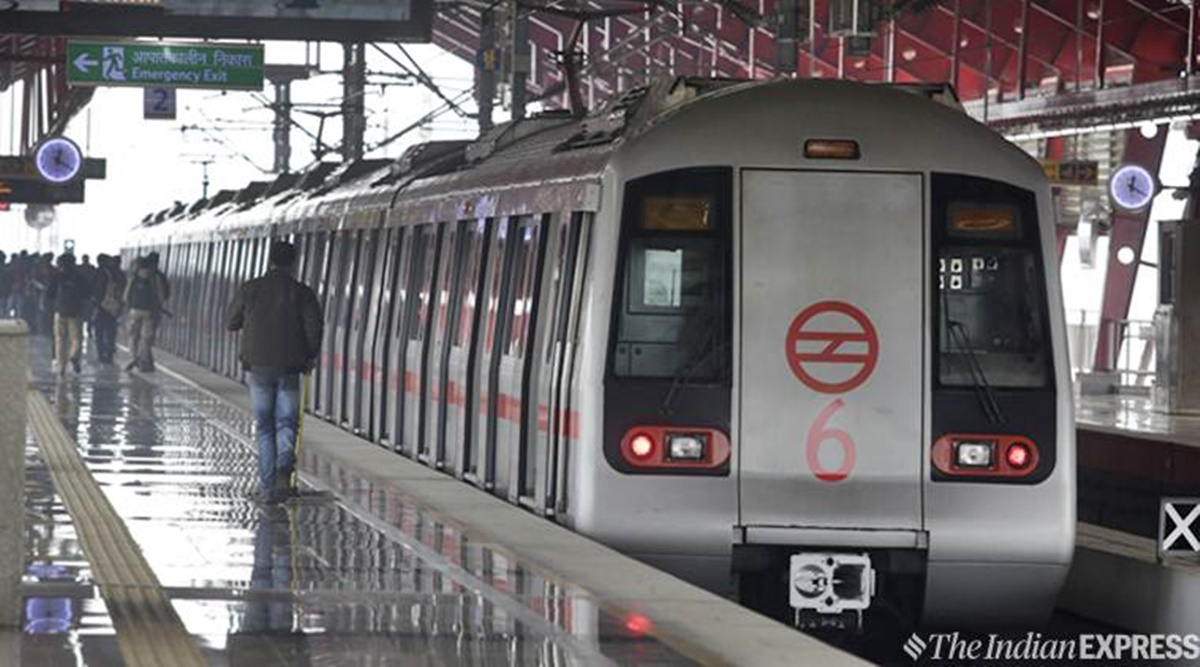 A senior DMRC official said the air inside the coaches is a mixture of 70-73% recycled air and 27-30% fresh air, pulled in from outside, at any given point. The ratio is comparable to the air inside subway coaches in New York. (File)
A senior DMRC official said the air inside the coaches is a mixture of 70-73% recycled air and 27-30% fresh air, pulled in from outside, at any given point. The ratio is comparable to the air inside subway coaches in New York. (File)AS IT prepares to begin operations from September 7, one of the key measures Delhi Metro is looking at is managing air circulation, to allow more fresh air from outside and to disperse any suspended viral particles. This will raise temperatures further from what’s to now be maintained inside coaches as a precaution against the coronavirus — in the range of 24-30 degrees Celsius.
The Indian Express spoke to the Delhi Metro Rail Corporation’s (DMRC) technical team and independent experts to figure out what India’s largest subway system is doing to emerge from Covid.
A senior DMRC official said the air inside the coaches is a mixture of 70-73% recycled air and 27-30% fresh air, pulled in from outside, at any given point. The ratio is comparable to the air inside subway coaches in New York.
When the trains are running with commuters, the air inside the coaches constantly get pulled in by the HVAC (heat, ventilation, air-conditioning), is cooled, filtered, and then released back. Outside air sucked in by the system is also released simultaneously into the coaches after passing through the same cooling and filtration units.
Consequently, air inside Delhi Metro coaches is fully replaced by outside air every 2 minutes and 33 seconds. The same process takes 3 minutes and 20 seconds in New York City subway, which since May 6 has shut down its services daily between 1 am and 5 am for disinfection drives — the first time in its history.
Infusion of fresh air at a faster rate is among the key measures that public transporters like the DMRC can take to reassure commuters, Columbia University Professor Faye Mcneill, an expert in atmospheric chemistry and aerosol, told The Indian Express.
“Ventilation systems should be set to bring in maximum fresh air. Where recirculation occurs, a high-grade air filter capable of capturing small particles should be used,” Mcneill said. The US subway systems, for example, use filters of standard MERV 13 or better, MERV standing for minimum efficiency reporting value, with a higher score meaning higher ability to block particulate matter.
Metro officials said they are planning to open fresh air dampers, which are essentially inlets to let air into the coaches, by up to 50 to 60 per cent more than usual. As a result, the interiors of the coaches will have temperatures between 24-30 degrees Celsius and may feel warmer than usual, an official said.
About the HVAC units, Metro officials said these had two types of filters — fresh air filters and return air filters, both made up of wire mesh and fibre to trap particles. “The cleaning frequency of HVAC filters will be doubled.
These will be disinfected using a 5 per cent bleach solution,” the DMRC said in a written reply to queries sent by The Indian Express.
In accordance with guidelines prepared by the Union Ministry of Housing and Urban Affairs, Metro trains will also halt for longer duration at terminal stations with their doors open to let fresh air in.
Asked about the possible build-up of pollutants in its underground stations, the DMRC said these were ‘open type’, meaning the interiors of the stations got free flow of air from entry and exit gates and the tunnels.
“As a result, air at the station platform and concourse (where ticket counters are located) areas get exchanged with outside air every time a train pulls in. Also, the air conditioning systems are designed in a way that fans get automatically activated when CO2 levels rise in a station,” the DMRC said.
Apart from this, Delhi Metro is also taking other precautionary measures such as sanitising passenger contact areas such as hand rails, poles and seats using Virex II 256, known to be a powerful disinfectant.
Metro workers have been directed to undertake cleaning and disinfection every four hours, including of the ticket vending machines, hand rails, lift buttons. The DRMC has also decided to do away with tokens and cash transactions.
Masks will be mandatory, while entry gates would be limited, halt times longer, alternate seats onboard kept vacant, and a distance of one metre maintained among those standing, to ensure social distances. Besides, only asymptomatic passengers would be allowed to enter the stations after thermal screening.
Professor Mcneill said controlling the spread of Covid-19 in indoor spaces, such as buses, subway cars, trains, was a challenge. “There is a very real possibility of contracting COVID-19 from a nearby infected person through coughing or sneezing. That being said, it is possible to keep safe with mask-wearing, social distancing, good ventilation and hand hygiene… These measures all work together — mask-wearing alone isn’t sufficiently protective if the subway is packed person- to-person (no social distancing) and has poor ventilation.”
What was also important, she pointed out, was how successful the city is in controlling community transmission. “If there is overall low spread of the disease, then the probability of transmission on public transit is less.”
Delhi Metro, which shut down in March, begins operations at a time when the Capital is again seeing a rise in cases after the situation stabilising. As on Sunday, Delhi had 1,73,390 cases (14,793 active).
With a network length of around 389 km with 285 stations across the NCR, Daily Metro has a daily average ridership of 27 to 30 lakh.